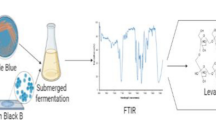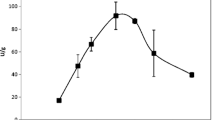Abstract
Optically pure D-lactic acid was produced from glucose, xylose, or starch by the combined use of Weissella sp. S26 and Bacillus sp. ADS3, two native bacterial strains isolated from Singapore environment. Weissella sp. S26 was used to ferment various sugars to lactic acid rich in D-isomer followed by sterilization of the broth and inoculation of Bacillus sp. ADS3 cells to selectively degrade acetic acid (if any) and L-lactic acid. In a simultaneous saccharification and fermentation of starch by Weissella sp. S26 in 1 L of modified MRS medium containing 50 g/L starch at 30 °C, lactic acid reached 24.2 g/L (23.6 g/L of D-isomers and 0.6 g/L of L-isomers), and acetic acid was 11.8 g/L at 37 h. The fermentation broth was sterilized at 100 °C for 20 min and cooled down to 30 °C followed by inoculation of Bacillus sp. ADS3 (10 %, v/v), and the mixture was kept at 30 °C for 115 h. Acetic acid was completely removed, and L-lactic acid was largely removed giving an optical purity of D-lactic acid as high as 99.5 %.





Similar content being viewed by others
References
Belma, A., Zehra, N.Y., & B.Y., (2002) Determination of PHB growth quantities of certain Bacillus species isolated from soil. Turkish Electric J Biotechnol Special issue.
Connolly, E. (2013). D(−)-lactic acid-producing bacteria safe to use in infant formulas. Natrafoods, 3, 37–49.
Desetty, R., Mahajan, V., Khan, B. M., & Rawal, S. (2008). Isolation and heterologous expression of PHA synthesising genes from bacillus thuringiensis R1. World Journal of Microbiology and Biotechnology, 24, 1769–1774.
Gouda, M. K., Swellam, A. E., & Omar, S. H. (2001). Production of PHB by a bacillus megaterium strain using sugarcane molasses and corn steep liquor as sole carbon and nitrogen sources. Microbiological Research, 156, 201–207.
Ismail, K. S., Sakamoto, T., Hasunuma, T., Zhao, X. Q., & Kondo, A. (2014). Zinc, magnesium, and calcium ion supplementation confers tolerance to acetic acid stress in industrial saccharomyces cerevisiae utilizing xylose. Biotechnology Journal, 9, 1519–1525.
Kodama, S., Yamamoto, A., Matsunaga, A., Soga, T., & Minoura, K. (2000). Direct chiral resolution of lactic acid in food products by capillary electrophoresis. Journal of Chromatography A, 875, 371–377.
Li, Q., Ng, W. T., Puah, S. M., Bhaskar, R. V., Soh, L. S., Macbeath, C., Parakattil, P., Green, P., & Wu, J. C. (2013). Efficient production of fermentable sugars from oil palm empty fruit bunch by combined use of acid and whole cell culture-catalyzed hydrolyses. Biotechnology and Applied Biochemistry. doi:10.1002/bab.1188.
Ma, K., Maeda, T., You, H., & Shirai, Y. (2014). Open fermentative production of l-lactic acid with high optical purity by thermophilic Bacillus coagulans using excess sludge as nutrient. Bioresource Technology, 151, 28–35.
Okino, S., Suda, M., Fujikura, K., Inui, M., & Yukawa, H. (2008). Production of D-lactic acid by Corynebacterium glutamicum under oxygen deprivation. Applied Microbiology and Biotechnology, 78, 449–454.
Paik, M. J., Nguyen, D. T., Yoon, J., Chae, H. S., Kim, K. R., Lee, G., & Lee, P. C. (2011). Chiral separation of lactic acid in culture media and cells of Lactobacillus delbrueckii subsp. lactis as O-pentafluoropropionylated. Nihon Geka Gakkai Zasshi, 32, 2418–2422.
Papagaroufalis, K., Fotiou, A., Egli, D., Tran, L. A., & Steenhout, P. (2014). A randomized double blind controlled safety trial evaluating d-lactic acid production in healthy infants Fed a lactobacillus reuteri-containing formula. Nutrition and Metabolism Insights, 7, 19–27.
Sun, J., Wang, Y., Wu, B., Bai, Z., & He, B. (2015). Enhanced production of d-lactic acid by Sporolactobacillus sp.Y2-8 mutant generated by atmospheric and room temperature plasma. Biotechnology and Applied Biochemistry, 62, 287–292.
Suwannasing, W., Imai, T., & Kaewkannetra, P. (2015). Cost-effective defined medium for the production of polyhydroxyalkanoates using agricultural raw materials. Bioresource Technology, 194, 67–74.
Tongpim, S., Meidong, R., Poudel, P., Yoshino, S., Okugawa, Y., Tashiro, Y., Taniguchi, M., & Sakai, K. (2014). Isolation of thermophilic l-lactic acid producing bacteria showing homo-fermentative manner under high aeration condition. Journal of Bioscience and Bioengineering, 117, 318–324.
Tsuji, H. (2005). Poly(lactide) stereocomplexes: formation, structure, properties, degradation, and applications. Macromolecular Bioscience, 5, 569–597.
Wang, J., & Yu, J. (2001). Kinetic analysis on formation of poly(3-hydroxybutyrate) from acetic acid by Ralstonia eutropha under chemically defined conditions. Journal of Industrial Microbiology & Biotechnology, 26, 121–126.
Wang, L., Zhao, B., Li, F., Xu, K., Ma, C., Tao, F., Li, Q., & Xu, P. (2011). Highly efficient production of D-lactate by Sporolactobacillus sp. CASD with simultaneous enzymatic hydrolysis of peanut meal. Applied Microbiology and Biotechnology, 89, 1009–1017.
Wang, Y., Tian, T., Zhao, J., Wang, J., Yan, T., Xu, L., Liu, Z., Garza, E., Iverson, A., Manow, R., Finan, C., & Zhou, S. (2012). Homofermentative production of D-lactic acid from sucrose by a metabolically engineered Escherichia coli. Biotechnology Letters, 34, 2069–2075.
Wee, Y. J., Kim, J. K., & Ryul, H. (2006). Biotechnological production of lactic acid and its recent applications. Food Technology and Biotechnology, 44, 163–172.
Ye, L., Hudari, M. S., Zhou, X., Zhang, D., Li, Z., & Wu, J. C. (2013). Conversion of acid hydrolysate of oil palm empty fruit bunch to L-lactic acid by newly isolated Bacillus coagulans JI12. Applied Microbiology and Biotechnology, 97, 4831–4838.
Yoshida, S., Okano, K., Tanaka, T., Ogino, C., & Kondo, A. (2011). Homo-D-lactic acid production from mixed sugars using xylose-assimilating operon-integrated lactobacillus plantarum. Applied Microbiology and Biotechnology, 92, 67–76.
Acknowledgments
This work was supported by the Science and Engineering Research Council (SERC) of the Agency for Science, Technology and Research (A*STAR), Singapore, under the Biomass to Chemicals Program (SERC Grants No. 1124004027 and No. 1326004117). Thanks are given to Ms. Ooi Kim Yng for her help in PHA analyses.
Author information
Authors and Affiliations
Corresponding author
Rights and permissions
About this article
Cite this article
Li, Q., Hudari, M.S.B. & Wu, J.C. Production of Optically Pure D-Lactic Acid by the Combined use of Weissella sp. S26 and Bacillus sp. ADS3. Appl Biochem Biotechnol 178, 285–293 (2016). https://doi.org/10.1007/s12010-015-1871-0
Received:
Accepted:
Published:
Issue Date:
DOI: https://doi.org/10.1007/s12010-015-1871-0




